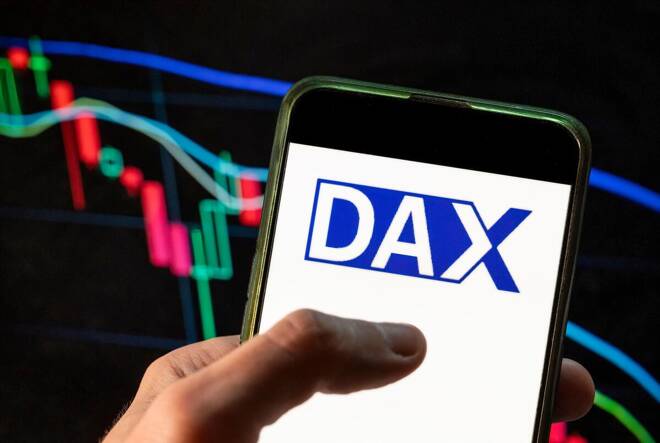Advertisement
Advertisement
Dax Index News: Will Geopolitical Risk and Fed Extend the Losing Streak?
By:
Key Points:
- DAX falls 0.29%, marking a four-day losing streak as auto stocks plunge amid US tariff fears and geopolitical risks.
- Eurozone wage growth hits 5.42% in Q3, sparking inflation concerns and doubts over ECB rate cut expectations.
- DAX futures up 47 points, but Ukraine war updates, ECB moves, and US data will dictate near-term market direction.
In this article:
DAX Extends Losing Streak to Four Sessions: Will Buyers Return?
On Wednesday, November 20, the DAX dropped by 0.29%, following a 0.67% decline on Tuesday, closing at 19,005. Geopolitical tensions over the Ukraine war and US tariffs continued to weigh on DAX-listed stocks.
Looming EU Tariffs Hit Auto Stocks
Alongside intensifying geopolitical tensions, the looming threat of US tariffs weighed on potential US trade targets.
The auto sector led the losses. Dr. Ing. h.c. F. Porsche AG Preferred Stock tumbled by 4.52%, while Mercedes Benz Group and Porsche fell by 1.85% and 1.81%, respectively. Volkswagen and BMW also posted losses.
Shifting sentiment toward ECB and Fed interest rate cuts weighed on real estate stocks, with Vonovia declining by 0.28%.
Eurozone Wage Growth Overshadows German Producer Price Trends
German producer prices declined by 1.1% year-on-year in October after falling 1.4% in September. Falling producer prices typically signal weakening demand, signaling softer inflationary pressures. Energy prices were down 5.6%, contributing to the decline.
While economists consider producer prices a leading indicator of inflation, Eurozone wage growth drew more interest.
Eurozone wage growth accelerated by 5.42% in Q3 2024, up from 3.54% in Q2 2024. Significantly, economists expected a more modest 3.7% increase. Rising wages could fuel consumer spending and demand-driven inflation, potentially dampening bets on aggressive ECB rate cuts. Tight labor market conditions could continue to support wage growth, a key focus for monetary policymakers.
While Eurozone wage growth accelerated significantly, economists viewed the surge as temporary due to one-off factors.
Pictet Wealth Management Head of Macroeconomic Research Frederik Ducrozet remarked on the wage growth figures, stating,
“Euro area negotiated wages surge to 5.4% YoY in Q3″ is the economic equivalent of a dead cat bounce. Old news, driven by Germany bonuses, at odds with the IG Metall deal, the ECB’s leading wage trackers, and the growth outlook.”
Eurozone Consumer Confidence in Focus
On Thursday, November 21, Eurozone consumer confidence trends could influence sentiment toward the ECB rate path. Economists expect the Consumer Confidence Index to increase slightly from -12.5 in October to -12.4 in November. Rising consumer confidence could drive spending, potentially fueling inflationary pressures.
US Equity Markets Deliver a Mixed Performance
On Wednesday, November 20, US equity markets delivered a mixed performance. The Nasdaq Composite Index slipped by 0.11%, while the Dow gained 0.32%. The S&P 500 ended the session flat.
Markets turned cautious before Nvidia’s (NVDA) earnings report. Nvidia declined by 2.53% in after-hours trading following guidance on supply constraints through 2026.
Key US Data to Watch
Shifting focus to Thursday’s US session, initial jobless claims need consideration. Economists forecast initial jobless claims to increase from 217k (week ending November 9) to 220k (week ending November 16).
An unexpected spike in jobless claims may refuel bets on a December Fed rate cut, potentially driving the DAX toward 19,350. Conversely, a sharp drop in claims could drag the DAX toward 18,750.
The US labor market remains a key consideration for the Fed, grappling with a robust labor market and elevated inflation.
Other economic indicators, including the Philly Fed Manufacturing Index and housing sector data, will likely play second fiddle to the labor market data.
Near-Term Outlook
In the near term, DAX trends will hinge on geopolitical tensions, central bank commentary, and US labor market data. Hawkish Fed comments, rising geopolitical risk, and upbeat US labor market data would likely weigh on the DAX. Conversely, easing tensions about the Ukraine war, support for December ECB and Fed rate cuts, and softer US labor market data may push the DAX higher.
As of Thursday morning, futures signaled a mixed session. DAX futures advanced by 47 points, while the Nasdaq mini futures were down by 71 points.
Investors should closely track the Ukraine war-related updates, US economic data, and central bank commentary for market cues.
DAX Technical Indicators
Daily Chart
After three consecutive daily losses, the DAX sits below the 50-day EMA while holding above the 200-day EMA. The EMAs signal bearish near-term but bullish longer-term price trends.
A DAX breakout from the 50-day EMA could signal a move toward 19,350. Furthermore, a return to 19,350 may enable the bulls to target 19,500 and the DAX’s all-time high of 19,675 into play.
Key drivers include updates on the Ukraine war, US economic data, and central bank commentary.
Conversely, a DAX drop below 19,000 may signal a fall toward 18,750.
With the 14-day RSI at 44.59, the DAX may fall through 18,750 before entering oversold territory.
About the Author
Bob Masonauthor
With over 28 years of experience in the financial industry, Bob has worked with various global rating agencies and multinational banks. Currently he is covering currencies, commodities, alternative asset classes and global equities, focusing mostly on European and Asian markets.
Latest news and analysis
Advertisement
